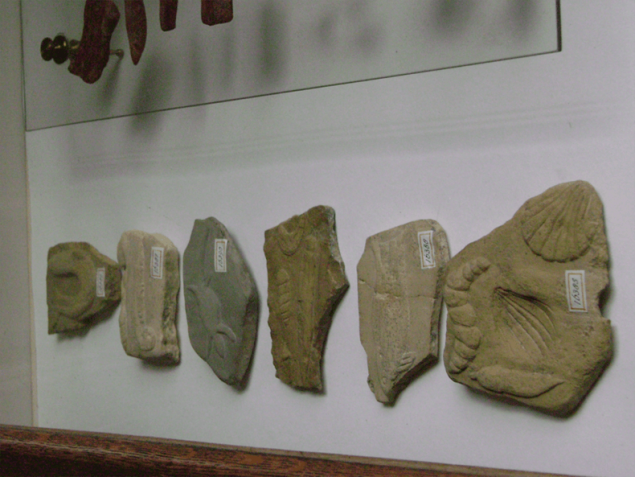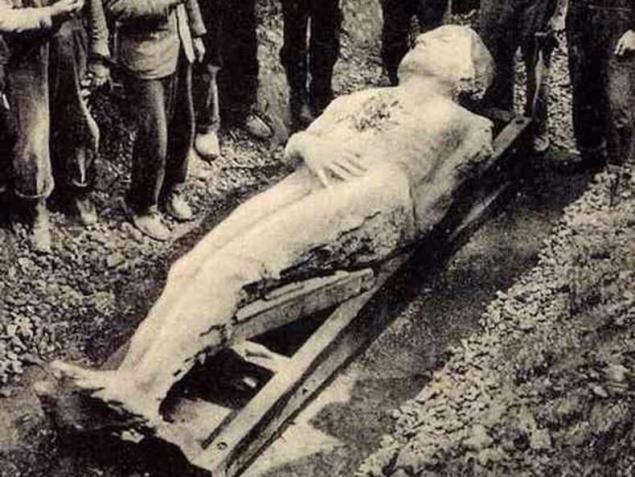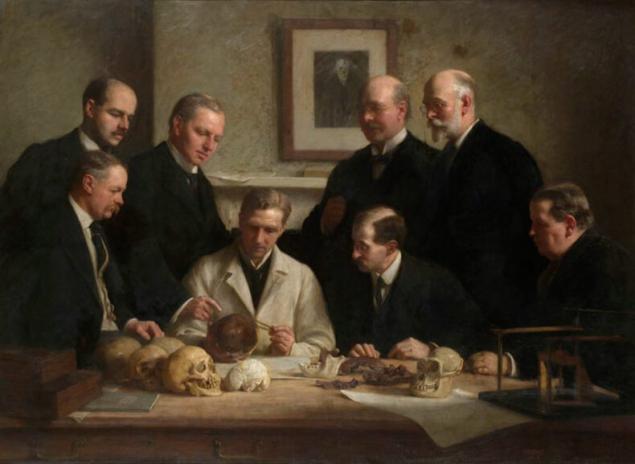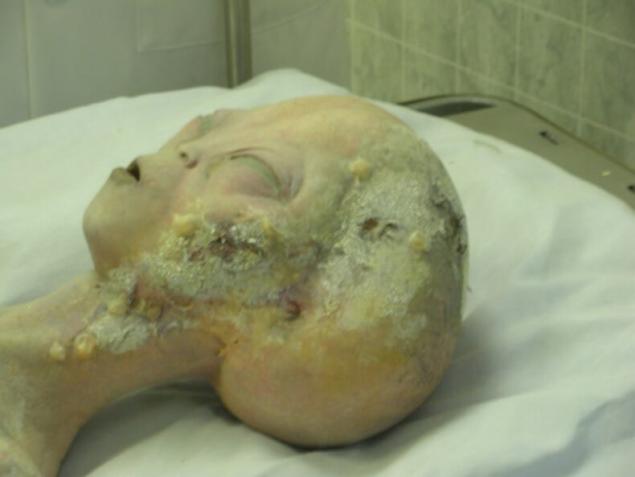10 pseudo-discoveries that shocked the scientific world
 Bashny.Net
Bashny.Net
The last century scientific discoveries are appearing with such speed that for them it is simply impossible to keep track of: electricity theory of relativity, the Internet. All these innovations changed our lives and brought science to a whole new level.
But sometimes incredible discoveries are actually amazing. Someone just decided to glue the bones found during the archeological excavations, for the sake of fame or gain.
To continue, we were less gullible, there's nothing better than to recall the most high-profile forgeries in the field of science. We present you the top 10 most famous scientific fakes.
Fossils Of Beringia (1725)

Finding:
A collection of fossils was found by students in the vicinity of the Bavarian town. They showed the discovery to his supervisor – Professor of medicine, University of Wurzburg, John Beringer. There were about 2000 stones, some had fingerprints of insects, lizards and other fossil plants and living organisms; on the other it was possible to distinguish between Hebrew letters and astronomical calculations. Beringer was so convinced that the stones were man made in the era of the great flood that he wrote and published a book about it.
Disclosure:
As soon as the book was published, a few guys brought him the last stone, on which was legibly his name. As it turned out, these stones were made and planted with colleagues Beringer, as a kind of revenge for the arrogance.
Source:
Museum of fakes (The Museum of Hoaxes), The Guardian
Eternal engine (1813)

Finding:
This "invention" is the brainchild of Charles Redheffer. He said that he had invented a motor that never stops.
Disclosure:
Paying attention to odd fluctuations, engineer and mechanic, Robert Fulton said he has found the source of "perpetual motion" machine. And he really found it was an elderly man who from time to time pulling the lever hidden in the attic.
Source:
The Guardian, a Museum of deception (The Museum of Hoaxes).
Life on the moon (1835)

Finding:
The newspaper the New York Sun has published information about what the astronomer John Hershel found the solution to almost all problems of mathematical astronomy, and he discovered several new planets. One of the most shocking discoveries was allegedly exists life on the moon.
Disclosure:
As it turned out later, John Herschel did not made these discoveries, he didn't even know about them, not to mention how to link them with his name.
Source:
Museum of deception (The Museum of Hoaxes).
The giant from Cardiff

Finding:
Petrified human body growth of about 3 meters was discovered by a group of workers digging up a well.
Disclosure:
An atheist named George hull created this giant joke on a friend of mine who was convinced that the Earth was once inhabited by giants, as written in the Bible. Later hull even tried to sue some with Petey Barnum (he decided to recreate the giant). However, hull lost the case because he could not prove that the first giant molded it.
Source:
The Washington Post, the Museum of deception (The Museum of Hoaxes).
Piltdown man (1912)

Finding:
The skull fragments are very similar to human, were found by Charles Dawson, a lawyer and Amateur archaeologist. The jaw structure was more typical of apes, and the skull still have a couple molars. Interest in the findings was the fact that she was presented as the missing link between man and APE, as Dawson suggested that the age of discovery – about 500 thousand years.
Disclosure:
In the 1950s again, the scientists reexamined the bones and found that the age of the skull is 50, not 500 thousand years. As for jaws, it was a couple decades older and really belonged to the monkey. In addition, the researchers found that the bones were specially processed with chemicals to give them a kind corresponding to the stated Dawson age. However, the most scams from this discovery, neither hot nor cold, because the time of exposure he was already dead.
Source:
The Washington Post, the Museum of deception (The Museum of Hoaxes), The Guardian.
The alien autopsy (1947)

Finding:
Videography of the autopsy of an alien that died in the crash of his spaceship in 1947 in the town of Roswell, the state of new Mexico. In 1995, Briton John had Santilli said that he has a video with this opening, which he got from a retired military cameraman.
Disclosure:
Statement ray did not go unnoticed, and the scientific community were required to produce a record, but ray did not want to open his deception and kept until 2006. But now he claims that the autopsy really was the place to be. Just the process of opening was in such a bad quality that he had to reconstruct it and to capture, in fact, a hoax.
Source:
The Guardian, a Museum of deception (The Museum of Hoaxes).
Tribe Tasaday-manouba (1971)

Finding:
The Minister of the Government of the Philippines Manuel Elizalde said that on the island of Mindanao was discovered tribe living in the stone age: "the tribe says in a strange language, is engaged in the gathering, use stone utensils, lives in caves and uses of plants and casting as a garment" — that's the way it was described in the Guardian newspaper. As a result, the President of the Philippines closed the island for researchers and visitors and declared his reservation.
Disclosure:
After the President was overthrown, two journalists snuck onto the island (in 1986). It turned out that the tribe live in houses, wear ordinary clothes, but a way of life of a primitive tribe they were only a short time at the insistence of Elizalde.
Source:
The Guardian, a Museum of deception (The Museum of Hoaxes).
Sinica is sponsored by fujimura engineering and his findings of the stone age (1981)

Finding:
Since Fujimura was already known as the archaeologist who found the ancient artifacts in Japan in 1981. In 2000, he allegedly discovered the artifacts age of about 600 thousand years. These findings would have much greater value because they would be the earliest evidence of human existence on earth.
Disclosure:
In 2000 a group of journalists took video of the process of instillation of "ancient artifacts". It turned out, the scientist independently manufactured and planted their "finds" on the site.
Source:
The Washington Post, the Museum of deception (The Museum of Hoaxes).
New elements of the periodic table (1998)

Finding:
Previously unknown radioactive elements were discovered by scientists at the national laboratory Lawrence Berkeley by exposure to krypton on lead. New items were named Ununoctium (118 elements) and Livermore (16 element). Then this revelation was referred to as "a breakthrough that opens new horizons in the study of the nucleus of an atom.
Disclosure:
The experiments were carried out before 2000, but the elements failed to synthesize. As a result, scientists retracted his statements, and Victor Ninova, was accused of falsifying information. By the way, in 2000 the named elements have been able to synthesize.
Source:
The Guardian, a Museum of deception (The Museum of Hoaxes).
The Remains Of Archaeoraptor (1999)

Finding:
The dinosaur fossils that have feathers. The find was claimed as the missing link between dinosaurs and birds.
Disclosure:
It turned out that the skeleton of archeoraptor was only a grab-bag of various bones, which were simply cemented: the upper torso was taken from an ancient bird, the tail is from a small winged dinosaur and the owner of the feet generally remain unknown.
Source:
The Washington Post, the Museum of deception (The Museum of Hoaxes).published
Translation: Anna Kiseleva
Neuroplasticity: the Brain reflects our environment, our decisions, emotions and lifestyle
When the Sun makes the Earth uninhabitable?
Source: mixstuff.ru/archives/114448
But sometimes incredible discoveries are actually amazing. Someone just decided to glue the bones found during the archeological excavations, for the sake of fame or gain.
To continue, we were less gullible, there's nothing better than to recall the most high-profile forgeries in the field of science. We present you the top 10 most famous scientific fakes.
Fossils Of Beringia (1725)

Finding:
A collection of fossils was found by students in the vicinity of the Bavarian town. They showed the discovery to his supervisor – Professor of medicine, University of Wurzburg, John Beringer. There were about 2000 stones, some had fingerprints of insects, lizards and other fossil plants and living organisms; on the other it was possible to distinguish between Hebrew letters and astronomical calculations. Beringer was so convinced that the stones were man made in the era of the great flood that he wrote and published a book about it.
Disclosure:
As soon as the book was published, a few guys brought him the last stone, on which was legibly his name. As it turned out, these stones were made and planted with colleagues Beringer, as a kind of revenge for the arrogance.
Source:
Museum of fakes (The Museum of Hoaxes), The Guardian
Eternal engine (1813)

Finding:
This "invention" is the brainchild of Charles Redheffer. He said that he had invented a motor that never stops.
Disclosure:
Paying attention to odd fluctuations, engineer and mechanic, Robert Fulton said he has found the source of "perpetual motion" machine. And he really found it was an elderly man who from time to time pulling the lever hidden in the attic.
Source:
The Guardian, a Museum of deception (The Museum of Hoaxes).
Life on the moon (1835)

Finding:
The newspaper the New York Sun has published information about what the astronomer John Hershel found the solution to almost all problems of mathematical astronomy, and he discovered several new planets. One of the most shocking discoveries was allegedly exists life on the moon.
Disclosure:
As it turned out later, John Herschel did not made these discoveries, he didn't even know about them, not to mention how to link them with his name.
Source:
Museum of deception (The Museum of Hoaxes).
The giant from Cardiff

Finding:
Petrified human body growth of about 3 meters was discovered by a group of workers digging up a well.
Disclosure:
An atheist named George hull created this giant joke on a friend of mine who was convinced that the Earth was once inhabited by giants, as written in the Bible. Later hull even tried to sue some with Petey Barnum (he decided to recreate the giant). However, hull lost the case because he could not prove that the first giant molded it.
Source:
The Washington Post, the Museum of deception (The Museum of Hoaxes).
Piltdown man (1912)

Finding:
The skull fragments are very similar to human, were found by Charles Dawson, a lawyer and Amateur archaeologist. The jaw structure was more typical of apes, and the skull still have a couple molars. Interest in the findings was the fact that she was presented as the missing link between man and APE, as Dawson suggested that the age of discovery – about 500 thousand years.
Disclosure:
In the 1950s again, the scientists reexamined the bones and found that the age of the skull is 50, not 500 thousand years. As for jaws, it was a couple decades older and really belonged to the monkey. In addition, the researchers found that the bones were specially processed with chemicals to give them a kind corresponding to the stated Dawson age. However, the most scams from this discovery, neither hot nor cold, because the time of exposure he was already dead.
Source:
The Washington Post, the Museum of deception (The Museum of Hoaxes), The Guardian.
The alien autopsy (1947)

Finding:
Videography of the autopsy of an alien that died in the crash of his spaceship in 1947 in the town of Roswell, the state of new Mexico. In 1995, Briton John had Santilli said that he has a video with this opening, which he got from a retired military cameraman.
Disclosure:
Statement ray did not go unnoticed, and the scientific community were required to produce a record, but ray did not want to open his deception and kept until 2006. But now he claims that the autopsy really was the place to be. Just the process of opening was in such a bad quality that he had to reconstruct it and to capture, in fact, a hoax.
Source:
The Guardian, a Museum of deception (The Museum of Hoaxes).
Tribe Tasaday-manouba (1971)

Finding:
The Minister of the Government of the Philippines Manuel Elizalde said that on the island of Mindanao was discovered tribe living in the stone age: "the tribe says in a strange language, is engaged in the gathering, use stone utensils, lives in caves and uses of plants and casting as a garment" — that's the way it was described in the Guardian newspaper. As a result, the President of the Philippines closed the island for researchers and visitors and declared his reservation.
Disclosure:
After the President was overthrown, two journalists snuck onto the island (in 1986). It turned out that the tribe live in houses, wear ordinary clothes, but a way of life of a primitive tribe they were only a short time at the insistence of Elizalde.
Source:
The Guardian, a Museum of deception (The Museum of Hoaxes).
Sinica is sponsored by fujimura engineering and his findings of the stone age (1981)

Finding:
Since Fujimura was already known as the archaeologist who found the ancient artifacts in Japan in 1981. In 2000, he allegedly discovered the artifacts age of about 600 thousand years. These findings would have much greater value because they would be the earliest evidence of human existence on earth.
Disclosure:
In 2000 a group of journalists took video of the process of instillation of "ancient artifacts". It turned out, the scientist independently manufactured and planted their "finds" on the site.
Source:
The Washington Post, the Museum of deception (The Museum of Hoaxes).
New elements of the periodic table (1998)

Finding:
Previously unknown radioactive elements were discovered by scientists at the national laboratory Lawrence Berkeley by exposure to krypton on lead. New items were named Ununoctium (118 elements) and Livermore (16 element). Then this revelation was referred to as "a breakthrough that opens new horizons in the study of the nucleus of an atom.
Disclosure:
The experiments were carried out before 2000, but the elements failed to synthesize. As a result, scientists retracted his statements, and Victor Ninova, was accused of falsifying information. By the way, in 2000 the named elements have been able to synthesize.
Source:
The Guardian, a Museum of deception (The Museum of Hoaxes).
The Remains Of Archaeoraptor (1999)

Finding:
The dinosaur fossils that have feathers. The find was claimed as the missing link between dinosaurs and birds.
Disclosure:
It turned out that the skeleton of archeoraptor was only a grab-bag of various bones, which were simply cemented: the upper torso was taken from an ancient bird, the tail is from a small winged dinosaur and the owner of the feet generally remain unknown.
Source:
The Washington Post, the Museum of deception (The Museum of Hoaxes).published
Translation: Anna Kiseleva
Neuroplasticity: the Brain reflects our environment, our decisions, emotions and lifestyle
When the Sun makes the Earth uninhabitable?
Source: mixstuff.ru/archives/114448
Tags
See also
When you change the world, and no one noticed
10 images that shocked the medical world
10 things science can not explain.
10 things science can not explain
Are there black holes
A selection of iconic images that shocked the world
Amazing people that shook the world
Amazing people, that shocked the world (29 photos)
Technology interstellar travel in science fiction
The two books that changed the life of Sergey Brin

















